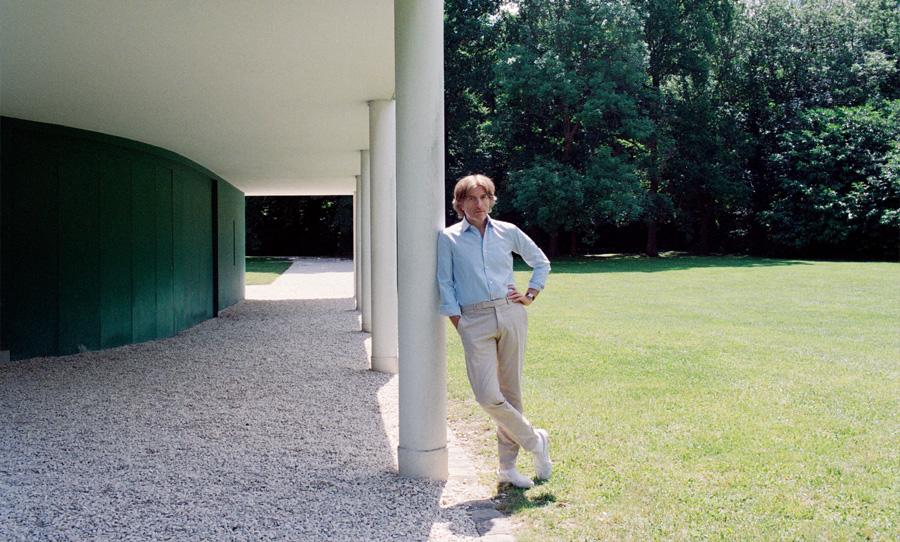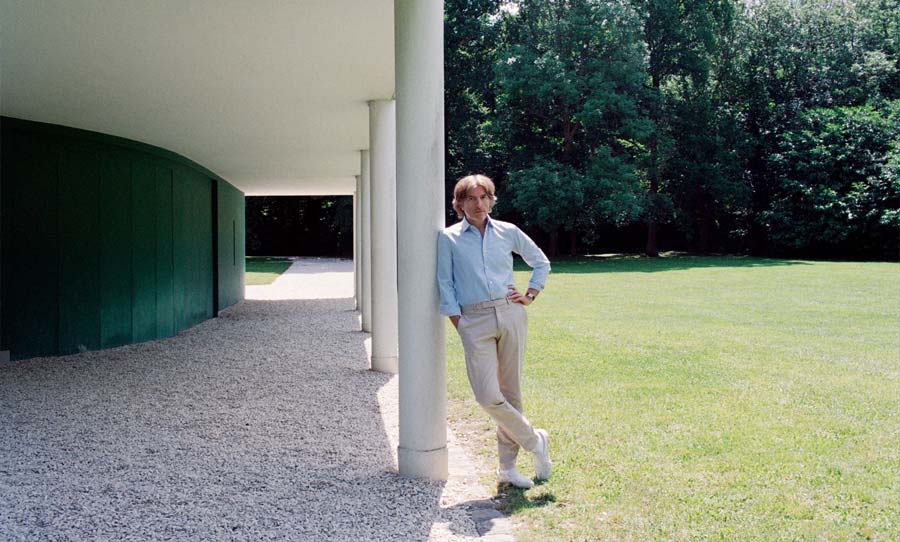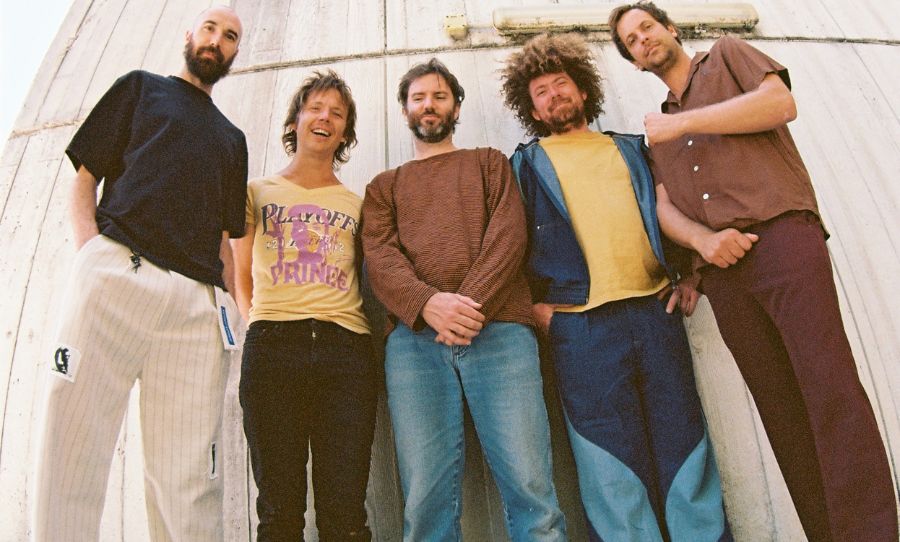As one half of French duo AIR, Nicolas Godin stole the world with a series of iconic releases in the late ’90s. Since then AIR has persisted but so has Godin’s solo career, composing a number of albums and film soundtracks which bask in the same spacious feel which made Moon Safari so groundbreaking.
Not to mention Godin is an architect, a discipline which stands at the centre of his new album Concrete and Glass. Inspired by seminal buildings and architects from around the world, the LP brims with a sense of space, permanence, and locale. When we spoke to him, he treated us to a few anecdotes about the recording of the album and an insight into AIR’s space-age glamour.

Does architecture inspire Nicolas Godin’s music, or are things the other way around? Examine Concrete and Glass through the eyes of its composer.
HAPPY: Concrete and Glass began when Xavier Veilhan asked you to compose music for some iconic pieces of architecture…
NICOLAS: Yes, actually. I composed a song for people who would visit that exhibition, they would hear each song – or a version of each song. But they were not finished songs, they were more like exhibition versions, they were five minutes long and I was looping them… there were less melodies but the harmonies were there. I studied from those harmonies to create these songs.
HAPPY: It’s an interesting idea to me, a song being a permanent part of a building like the bricks or the windows.
NICOLAS: Yeah – when you watch a movie you can hear the music and to everybody, that’s a normal thing to do. I think art should have music too, you know? Maybe one day you will go to an exhibition and you will hear some music, and it will be as natural to you as watching a movie.
HAPPY: And to clarify, those original compositions, none of those are what ended up on Concrete and Glass?
NICOLAS: No, everything has been redone. I think I made the songs three times – the first was for the exhibitions, then I tried to transform them to record, but then I wanted people to be able to hear the album without ever knowing about [the exhibitions], so I had to record a third time to make the songs like original ideas, to become independent. I wanted the songs to be really independent from their origins, you know?
HAPPY: Did the buildings, style, or architects you originally worked from stay in your mind during that re-recording process?
NICOLAS: Yes. Every song is related to a specific building picked by Xavier Veilhan. I had to go there for each house, I had to travel to step in the house for a few days. I got inspired by the shape, the materials, the landscape, the story of the house, by the era… and actually, the acoustics of each house. Like a church made of concrete in France, or a house made of marble. There’s a certain colour of sound you want to apply to each house.
HAPPY: I’m probably being a bit of a smartass here, but is the title a reference to Philip Glass or musique concrète?
NICOLAS: Oh! I never thought about that but it’s… wow! (Laughs) And actually I’m a teacher of that – Glass, musique concrète, Reich.
HAPPY: The album is about how architecture inspires music, but have you ever operated the other way around? Letting music inspire your work as an architect?
NICOLAS: Wow, this is something I’ve never thought about as well! That would be a good idea. The thing with that is it’s easier to make an album than it is to make a house (laughs). You just need a computer, a bass, and a synthesiser. When you build a house as an architect it’s such a long process and it requires a lot of money, a lot of manpower, you know? Human resources.
HAPPY: Yeah. We’re about to go a bit conceptual, but what do you think is more important about a piece of art; the place it’s in, or the art itself? For instance when you look at a building in Paris, you could see its ‘Frenchness’ or the actual style. When you’re looking at art or listening to a song, what do you take away?
NICOLAS: It’s a really good question. I would say that what I like about houses is that houses are not independent, actually. You cannot have a house without having a location first, and the location determines how you make the house. You never build a house that could be anywhere.
HAPPY: I like that.
NICOLAS: I think location creates context and it creates limitation, and limitation is what gives you the ideas – and if you don’t have limitation and you don’t have context, you can’t make a house. I cannot imagine a house that could be made anywhere – a house has to be somewhere. I think that’s why art needs to have its context.
HAPPY: Good answer. I ask because AIR, to me, is deeply related to space – and something like space is a bit less tangible than a building or a place. With AIR were you trying to escape a more defined context?
NICOLAS: AIR is in fact two things, it’s air like space itself and it’s also space like the moon and stars. For the people of my generation, my age, we have been told since we were children that in the year 2000 there would be spaceships and that we would be travelling in space. Nothing like that ever happened, except for certain people on the other side of the world, so it was all still a fairytale – I still don’t have a spaceship parked in my backyard. So I grew up with this future that marketing sold to me when I was a child, and that was what the future was with AIR. The other space thing is like a landscape. When you walk in a park or in a palace or a garden or something, or these elements of classical French architecture, you put some headphones on and you can really hear that sound in the soundtrack. Those two types of space we really combined into our music, especially with AIR.
HAPPY: Thanks for that answer. I spoke to SebastiAn from Ed Banger Records recently, and I asked him about art and his music – he actually said that the buildings in Belgrade had stood out to him as something that was very conceptually close to his music. Brutalist Yugoslavian but also some quite beautiful Ottoman architecture…
NICOLAS: I can picture that.
HAPPY: I know, it was really spot on. Is there a place or a person that you think, architecturally, hits the same notes as your music?
NICOLAS: I think all these architects from the experiences I’ve just been through… John Lautner, and Xavier Veilhan. I think it’s an exact materialisation of all the things that I love in my life. That would be a dream to live in one of [Veilhan’s] houses. I saw a lot of artists through him and it made me realise that it was exactly what I wanted to do with my music.
HAPPY: Being able to travel the world as a musician must have been very useful to you as an architect.
NICOLAS: Exactly, especially when I go to Australia because I think in my top five buildings in the world is the Opera House, which is the most amazing place. I grew up almost knowing it as such an iconic building for me, and to be there as a musician is… you know.
HAPPY: While I have you, I couldn’t resist asking about gear.
NICOLAS: Oh, no problem. I’m a big fan of gear, I love talking shop.
HAPPY: Since we’re talking about architecture and space, I wanted to ask – is the structure of a synthesizer or a guitar important to you, or is it all about the sound?
NICOLAS: No, I cannot make music on an instrument that’s ugly. It’s like I need both, you know? For example I cannot play guitar on a not well-made guitar, and there’s some colours on a synthesizer that I cannot create with, I’m not inspired. I’m really inspired by the look of instruments and I hate instruments that… I cannot even make a sound on instruments if I don’t like the way they look.
HAPPY: I think I’m the same. I’ve said to a few people before – mostly as a joke – that the heavier a synthesizer it is, the better it sounds. What do you think?
NICOLAS: I think so. I’m trying to find an example – something that’s lightweight but still sounds great… but I think it’s true.
HAPPY: Have you used any new instruments on Concrete and Glass? Or do you mostly find yourself coming back to the old favourites?
NICOLAS: No, it’s always new and old at the same time. I used a EMS 2000 vocoder which I never used with AIR because in Concrete and Glass I wanted a more German sound, more like Kraftwerk than AIR. Also I put new strings on a bass that I’m familiar with, I had to find a new bass style and new basslines because of it. I used the Jupiter 8 and a Prophet 5 which I never used for AIR, and I used an ARP 2600. The two main sounds on the album are the Jupiter 8 and Prophet 5, then the ARP 2600.
HAPPY: I have to say I’m jealous. Well, thank you for the interview.
NICOLAS: Thank you.
Concrete and Glass is out now via Because Music / Caroline Australia.



